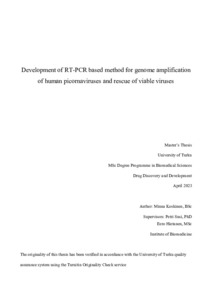Development of RT-PCR based method for genome amplification of human picornaviruses and rescue of viable viruses
Koskinen, Minna (2023-04-27)
Development of RT-PCR based method for genome amplification of human picornaviruses and rescue of viable viruses
Koskinen, Minna
(27.04.2023)
Julkaisu on tekijänoikeussäännösten alainen. Teosta voi lukea ja tulostaa henkilökohtaista käyttöä varten. Käyttö kaupallisiin tarkoituksiin on kielletty.
avoin
Julkaisun pysyvä osoite on:
https://urn.fi/URN:NBN:fi-fe2023060652697
https://urn.fi/URN:NBN:fi-fe2023060652697
Tiivistelmä
Picornaviruses (family Picornaviridae), causing diseases form respiratory illness to life-threatening CNS disease, are among the most common human pathogens. More than 300 human picornavirus types have been currently identified, yet there are no antivirals or vaccines against the common picornavirus types. Picornaviruses are RNA viruses and thus prone to mutations, which alter the virus tropism and pathogenesis. Viral cDNA clones or vectors are essential in the studies of picornaviruses. The standard cDNA clone production methods, however are cumbersome and old fashioned.
The aim of the thesis was to create a streamlined, robust method for amplification of picornaviral RNA genome to enable easy mutagenesis and generation of functional viral vectors.
To amplify viral RNA and cDNA clones with the backbone of coxsackievirus A9 and human parechovirus 1, four RT enzymes and five PCR enzymes, respectively, were used. PCR parameters (primer and nucleotide concentrations, number of cycles, performance based on copy numbers) were assessed to compile an optimal protocol. Further plans were made to follow virus rescue after cell transfection of viral genomes cloned under T7 promoter. Finally, HuTu80 cell line was evaluated for its suitability for parechovirus propagation and for reverse genetics experiments.
Platinum SuperFi II DNA polymerase was the most robust and sensitive PCR enzyme and allowed amplification from 102 viral cDNA genome copies. It performed consistently and worked on a wide range of nucleotide and primer concentrations. LunaScript and SuperScript IV produced the best results in RT step and were also the most straightforward in use. Parechovirus growth in HuTu80 cell line was observed based on cytopathic effect, suggesting that HuTu80 cells are suitable for further parechovirus studies.
In all, novel findings were made to develop a sensitive and robust protocol for amplification of full-length picornaviral genomes. Together with further optimization and optimal regulatory primers, it should allow efficient and sensitive viral genome amplification from small RNA amounts. This study paves way for development of modified viruses for pathogenicity studies and for oncolytic virotherapy.
The aim of the thesis was to create a streamlined, robust method for amplification of picornaviral RNA genome to enable easy mutagenesis and generation of functional viral vectors.
To amplify viral RNA and cDNA clones with the backbone of coxsackievirus A9 and human parechovirus 1, four RT enzymes and five PCR enzymes, respectively, were used. PCR parameters (primer and nucleotide concentrations, number of cycles, performance based on copy numbers) were assessed to compile an optimal protocol. Further plans were made to follow virus rescue after cell transfection of viral genomes cloned under T7 promoter. Finally, HuTu80 cell line was evaluated for its suitability for parechovirus propagation and for reverse genetics experiments.
Platinum SuperFi II DNA polymerase was the most robust and sensitive PCR enzyme and allowed amplification from 102 viral cDNA genome copies. It performed consistently and worked on a wide range of nucleotide and primer concentrations. LunaScript and SuperScript IV produced the best results in RT step and were also the most straightforward in use. Parechovirus growth in HuTu80 cell line was observed based on cytopathic effect, suggesting that HuTu80 cells are suitable for further parechovirus studies.
In all, novel findings were made to develop a sensitive and robust protocol for amplification of full-length picornaviral genomes. Together with further optimization and optimal regulatory primers, it should allow efficient and sensitive viral genome amplification from small RNA amounts. This study paves way for development of modified viruses for pathogenicity studies and for oncolytic virotherapy.
